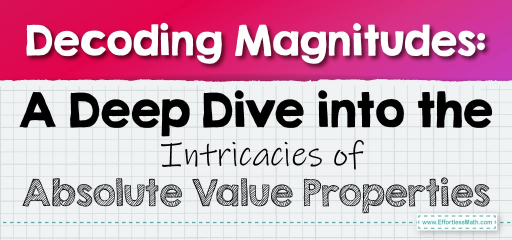Decoding Magnitudes: A Deep Dive into the Intricacies of Absolute Value Properties
Navigating the vast landscape of mathematics, one often encounters signposts that elucidate profound truths; among these, the properties of absolute values stand as beacons of clarity and depth. "Decoding Magnitudes: A Deep Dive into the Intricacies of Absolute Value Properties" embarks on an explorative journey, unraveling the multi-layered facets of these mathematical magnitudes. Within this article, readers will traverse from foundational principles to nuanced interpretations, all while fostering a deeper appreciation for the elegance of absolute values.

Step-by-step Guide to Learn Absolute Value Properties
Here is a step-by-step guide to learning absolute value properties:
Step 1: Setting the Stage – The Core Definition
Delve into the foundational essence of absolute values. At its heart, the absolute value of a number measures its “distance” from zero on the number line, disregarding any negative sign. This intrinsic property ensures all outputs are non-negative.
Step 2: Unlocking Basic Properties
Before venturing into the labyrinthine corridors of advanced properties, familiarize yourself with the rudimentary tenets:
a. \(∣ \ a∣≥0\) for all real numbers \(a\).
b. \(∣−a∣=∣a \ ∣\) – A testament to the non-directional nature of distance.
Step 3: Delving Deeper – Multiplicative Nuances
Engage with the intriguing property of multiplication within absolute values:
\(∣a×b∣=∣a∣×∣b \ ∣\)
This showcases the commutative characteristic of multiplication when encompassed within absolute barriers.
Step 4: Navigating the Realms of Addition and Subtraction
Dive into the more intricate property concerning addition:
\(∣a+b∣≤∣a∣+∣b \ ∣\)
Known as the Triangle Inequality, this principle echoes geometric truths found in the world of triangles.
Step 5: Inverse Operations – Division’s Role
Ponder over the less intuitive, yet profound division property:
\(\frac{∣a \ ∣}{∣b \ ∣}=\)∣\(\frac{a}{b}\)∣ (given \(b≠0\))
Step 6: Exploring Squares and Absolute Values
Illuminate your understanding by recognizing that the square of an absolute value reinforces its non-negativity:
∣\(a\)∣\(^2\)\(=a^2\)
Step 7: A Dance with Zero – Absolute Value’s Interaction
Entrench your knowledge by internalizing:
a. \(∣ \ a∣=0\) if and only if \(a=0\).
b. If \(∣ \ a∣>0\), then certainly, \(a≠0\).
Step 8: Journeying Beyond – Extensions to Complex Numbers
While our odyssey has primarily encompassed real numbers, venture a step further. When diving into complex numbers, absolute value (or modulus) translates to the distance from the origin in the complex plane.
Step 9: Intuitive Connections – Real-world Analogies
Bridge theoretical postulates with tangible scenarios. Consider debt as a real-world embodiment of absolute value: while owing \($10\) and being owed \($10\) might have different implications for your pocket, the magnitude, or “absolute” amount, remains \($10\) in both cases.
Step 10: Culminating Reflections – Synthesizing Knowledge
Having meandered through the intricate tapestry of absolute value properties, take a moment to reflect. Connect individual threads, synthesizing them into a cohesive understanding that paints a vivid picture of the absolute value’s multifaceted nature.
Final Word
Embarking on this voyage through the properties of absolute values is akin to decoding a sophisticated symphony: each note, each pause, has its purpose. As you peel back layers of complexity, remember that at the heart of it all lies a simple, powerful notion of mathematical “distance” and non-negativity. Embrace the journey, and let every property be a revelation of logic’s beauty.
Examples:
Example 1:
Evaluate \(∣−3×4∣\).
Solution:
Let’s consider \(a=−3\) and \(b=4\).
To find \(∣−3×4∣\): \(∣−12∣=12\)
Using the property \(∣ \ a×b∣=∣a∣×∣b∣\):
\(∣−3∣×∣4∣=3×4=12\)
Both methods yield the same result, \(12\), illustrating the property.
Example 2:
Evaluate \(∣−5+2∣\).
Solution:
Let’s consider \(a=−5\) and \(b=2\).
To find \(∣−5+2∣\): \(∣−3∣=3\)
Using the property \(∣ \ a+b∣≤∣a∣+∣b∣\):
\(∣−5∣+∣2∣=5+2=7\)
Here, \(∣−5+2∣\) gives \(3\), which is indeed less than or equal to \(7\) (the result from \(∣−5∣+∣2∣\)), thus confirming the triangle inequality.
Related to This Article
More math articles
- Addition of Hundreds
- Supermarket Sweep: How to Choose the Better Coupon in Aisle 7!
- Quadratic Function
- A Comprehensive Collection of FREE ACT Math Practice Tests
- Top 5 ACT Math Study Guides
- Top 10 3rd Grade FSA Math Practice Questions
- 10 Most Common 3rd Grade PARCC Math Questions
- TExES Core Math Practice Test Questions
- 5th Grade Georgia Milestones Assessment System Math Practice Test Questions
- How to Find Fractions of Time Units


























What people say about "Decoding Magnitudes: A Deep Dive into the Intricacies of Absolute Value Properties - Effortless Math: We Help Students Learn to LOVE Mathematics"?
No one replied yet.